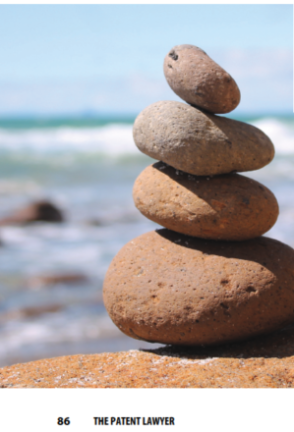A careful balance: injunctions, patentees’ rights and public interest
It is important for the Courts to find the right balance between patentees’ rights and the public interest when deciding whether to grant an injunction. Rachel Mumby and Olivia Henry explore some of the issues which come up in the life sciences sector.
22.12.2020

This article was first published on the Patent Lawyer Magazine, December 2020.
Patents provide exclusionary rights. It is stated in TRIPS[1] that judicial authorities should have the power to issue injunctions to prevent patent infringement. Indeed, following a finding of infringement of a valid patent, often after a hard-fought trial, many patentees want to ensure that their right to exclude others is exercised.
In England, injunctions are a discretionary remedy[2]. Often it is clear that an injunction is the appropriate remedy; whereas in other circumstances, the patentee’s exclusionary rights need to be fettered in order to strike a balance between the rights of the patentee and the public interest. Indeed, whether or not an injunction should be granted, the scope of that injunction, and what should be provided in lieu of the injunction can be the subject of significant debate.
When considering patent injunctions, it is important to remember the policy considerations underlying the patent system. In particular, the patent system is designed to promote innovation. Patentees are given an exclusionary right with a 20-year term in return for disclosing their invention to the world. During the patent term, prices are generally kept relatively high and the choices open to those wanting to use the patented invention can be restricted, neither of which are themselves directly in the public interest, but this is balanced out by the public interest in stimulating and sharing innovation.
It should also be kept in mind that the impact of a Court refusing an injunction is in effect to force the patentee to grant a licence. If specific public interest criteria are met, compulsory licences and crown use exemptions are available which in effect (and likely temporarily) deny the patentee of their exclusionary rights. Alternatively, patentees may decide voluntarily to forego their exclusionary rights and even, potentially, their rights to any compensation for infringement.
However, absent the statutory tests being met, the English Courts have historically been reluctant to insist on licences being granted[3].
Is it right to grant an injunction?
In the life sciences sector, many will be familiar with disputes between a patentee and a third party which wants to launch a generic version of a particular medicine. In these circumstances, an injunction is often particularly important to a patentee. This is because there are usually severe pricing implications if a generic version of a particular medicine is launched.
However, complications can arise. One area of debate is what to do when the particular medicine is authorised for two or more indications and the use of the particular medicine to treat only one of these indications is patent protected (a so called “skinny label” situation). A second area of debate is what to do when a company is not trying to launch a generic version of an existing medicine, but wants to launch a new medicine or medical device which is covered by a third party patent, especially in circumstances where that new medicine or medical device also satisfies an area of unmet clinical need.
Skinny label injunctions
The UK Supreme Court grappled with the appropriate balance in Actavis v Eli Lilly[4] when analysing infringement. They did not reach a consensus on the solution to the problem, but were seen by many as being relatively antipatentee in their analysis. (Notably, in that case, the relevant patent was, in any event, invalid and of a specific claim format). It seems clear that in future cases a standard injunction “not to infringe” is unlikely to be appropriate, and careful consideration of the particular circumstances will be needed to ensure that the right balance is made. Some consider that no injunction should be available at all in such circumstances and that a royalty is the appropriate remedy. Others consider that that will potentially stifle innovation and instead steps can reasonably be taken to ensure that an injunction is workable and the generic medicine is to the extent possible only used for the nonpatented use. Many commentators suggest that the answer lies not only in the patent regime but in the regulatory regime.
Unmet clinical need
There have been a number of life sciences cases in recent years where the patentee has not sought to exercise the full scope of its exclusionary rights. In such cases, the patentee has either decided not to seek an injunction, or has accepted that it is appropriate to make carve-outs from the scope of the injunction. In particular, in cases relating to unmet clinical need, patentees and the Courts have shown a desire over recent years to ensure that, as far as possible, the right balance is struck. This means ensuring that an injunction will not prevent patients from receiving treatment (at least not for patent law reasons), but at the same time ensuring that the remedies available do continue to incentivise patentees to carry on their research. For example, in Merck v Ono[5], GSK v Wyeth[6] and MSD v Wyeth[7] the patentees decided not to seek injunctive relief at all. Similarly, in Edwards Lifesciences v Boston Scientific[8] and in Regeneron v Kymab[9], the parties agreed that there would be certain carve-outs from the scope of any injunction and that certain aspects would be stayed.
In Evalve v Edwards Lifesciences[10], handed down in March 2020, Birss J was again asked to consider the public interest in the context of patent infringement. In his judgment, Birss J noted the importance of getting the balance right between the public interest and encouraging innovation. He also noted that it is important that investment in research takes place over many years, therefore there needs to be long term certainty for patentees that a return can be made.
When considering the balance, Birss J observed that there are a number of aspects of the UK Patents Act, in which the public interest plays a part. For example, the identification of non-patentable subject matter, exceptions to infringement for clinical trials, and for obtaining marketing authorisations, and the statutory compulsory licensing and crown use regimes. Birss J was also concerned (as others had been previously) that not granting an injunction would be akin to granting a compulsory licence without requiring compliance with the statutory tests.
Birss J noted that a big part of the balance is considering the appropriate financial compensation which should be paid to the patentee in lieu of the injunction. He noted that, on the one hand, any reasonable royalty would likely “grossly undercompensate” the patentee and would result in “substantial, quantifiable and uncompensated economic harm” which the patentee would have to bear in the public interest. But on the other hand, an account of the infringer’s profits (if available) would mean that the infringer would make no profit and therefore have no incentive to supply the market (which would be contrary to the public interest in keeping both products available)[11].
In his summary, Birss J identified seven general principles which are a useful guide for anyone considering these issues. In particular, he made clear that “the availability of an exclusionary injunction is an important manifestation of the monopolistic nature of a patent right. While monopolies in general are against the public interest, once a patent has been found valid and infringed, the patent monopoly is something which it is in the public interest to protect by an injunction in order to further the purposes of the system as a whole, such as to promote investment in innovation.” Also, “when various public interests are engaged and pull in different directions, one should have in mind that the legislator is better equipped than the courts to examine these issues and draw the appropriate broad balance. The jurisdiction to refuse or qualify a patent injunction on public interest grounds is not there to redraw the broad balance of public interests set by Parliament in the patent system. The power should be used sparingly and in limited circumstances.”
Compulsory licences and crown use
The Evalve decision (discussed above) was handed down on 12 March 2020, by which time the potential impact of the Covid-19 pandemic both on health services and on economies all over the world was a big concern for many. Perhaps Birss J had this in mind in Evalve v Edwards Lifesciences when referring to “special cases, such as a novel pandemic disease” when “the Government could invoke Crown use.”
Both compulsory licences and crown use are subject to complex and detailed requirements as set out in the UK Patents Act[12]. Neither were something that had been considered by many patent lawyers for several years until the prospect was raised in 2019 in the context of the cystic fibrosis medicine, Orkambi (following protracted negotiations between the NHS and the patentee, Vertex) and then by Jeremy Corbyn in his Autumn 2019 general election campaign. Once Boris Johnson had won the election and Vertex and the NHS had come to an arrangement[13], some thought that the concepts had been put to bed for a while. However, the issue of a crown use defence was raised successfully in IPCom v Vodafone, a case which relates to network services for the emergency services[14]. The Covid-19 pandemic then hit and the potential for these issues to be raised came to the attention of patent lawyers again.
To date, these statutory regimes have not been relied on before the Courts in the fight against Covid-19. instead, as expected by many, companies have endeavoured to maintain control of the licensing situation by entering into their own licences with third parties, rather than risk this being imposed by the Court. However, if the UK Government were to rely on crown use exemptions, or if compulsory licences are sought, it is clear that issues such as the financial compensation payable to patentees in lieu of an injunction will be very difficult to analyse.
Now that vaccines are very much on their way, there appears to be an end in sight to the pandemic. However, it cannot be excluded that either in this pandemic or in future emergencies, and notwithstanding cautiousness around public relations issues, some patentees will not be able to afford to give the UK government a royalty free licence, perhaps favouring efforts to support access to medicines in developing countries if they can. Whilst there are several notable exceptions, it is also understandable that many of those companies which have made large scale global pledges about free access to Covid-19 related IP are tech companies, rather than life sciences companies which plough billions of dollars into development of new medicines and into clinical trials every year and which need to be able to recoup their costs.
It appears that whilst there will need to be flexibility and carve-outs for special circumstances, injunctions are here to stay. They are an important part of the careful balance that has been created within the patent system between the public interest and the rights of the patentee. Ultimately, what is important is that the right incentives are there to encourage innovation and to protect humanity from current and future diseases.
—————————
[1] Agreement on Trade-related aspects of Intellectual Property Rights – Article 28(1)
[2] It is also stated in Article 28 of TRIPS that exclusions can apply. Further, Article 3(2) of the Enforcement Directive requires remedies to be proportionate.
[3] See e.g., Arnold J in HTC v Nokia [2013] EWHC 3778(Pat) at paragraphs 13 – 15 and also Biogen v Medeva [1993] RPC 475 where Aldous J held that “it was not the task of the Court to legalise wrongful acts even if the defendant could be considered to be a public benefactor because it was producing a life-saving vaccine.”
[4] [2017] UKSC 48
[5] [2015] EWHC 2973 (Pat)
[6] [2016] EWHC 1045 (Ch)
[7] [2020] EWHC 2636 (Pat)
[8] [2018] EWHC 1256 (Pat)
[9] [2018] EWCA 1186 (Civ). The Supreme Court handed down its decision in a further appeal on validity in June 2020 and held the patents to be invalid.
[10] [2020] EWHC 513 (Pat)
[11] This is something which had also concerned Henry Carr J in GSK v Wyeth [2017] EWHC 91 (Pat).
[12] Sections 48 – 50 for compulsory licences and sections 55 – 59 for crown use.
[13] https://www.england. nhs.uk/2019/10/ nhs-england-concludeswide- ranging-deal-forcystic- fibrosis-drugs/
[14] See IPCom v Vodafone [2020] EWHC 132 (Pat) which is under appeal.


